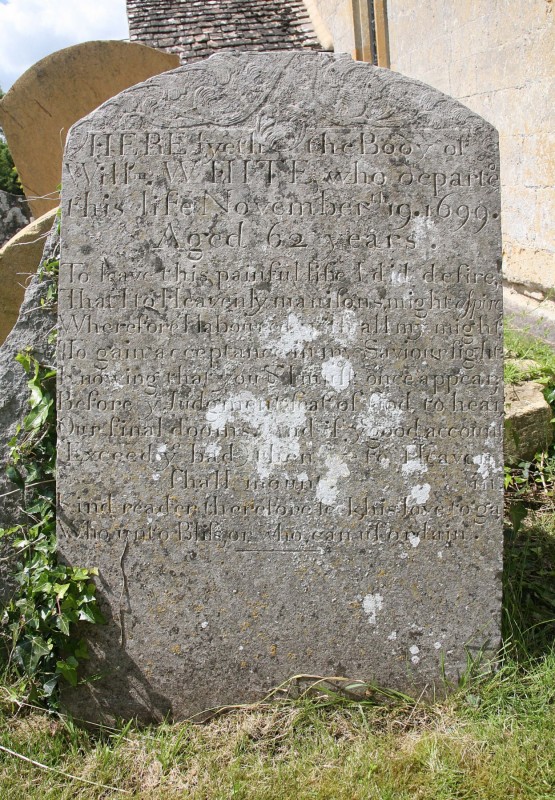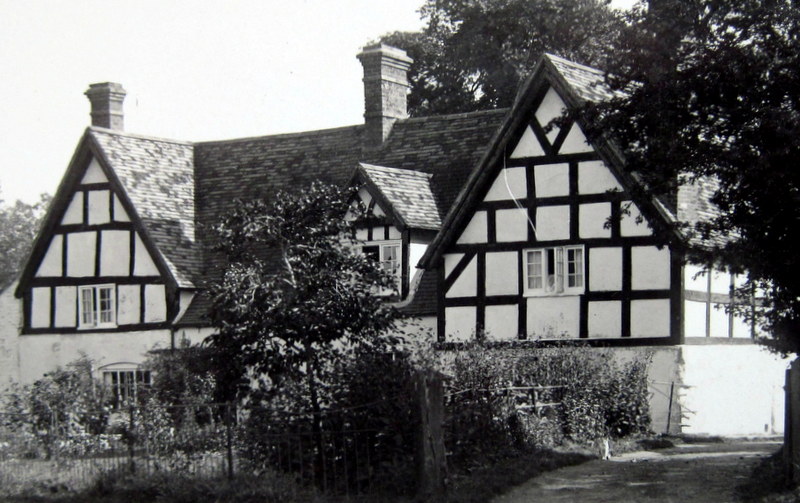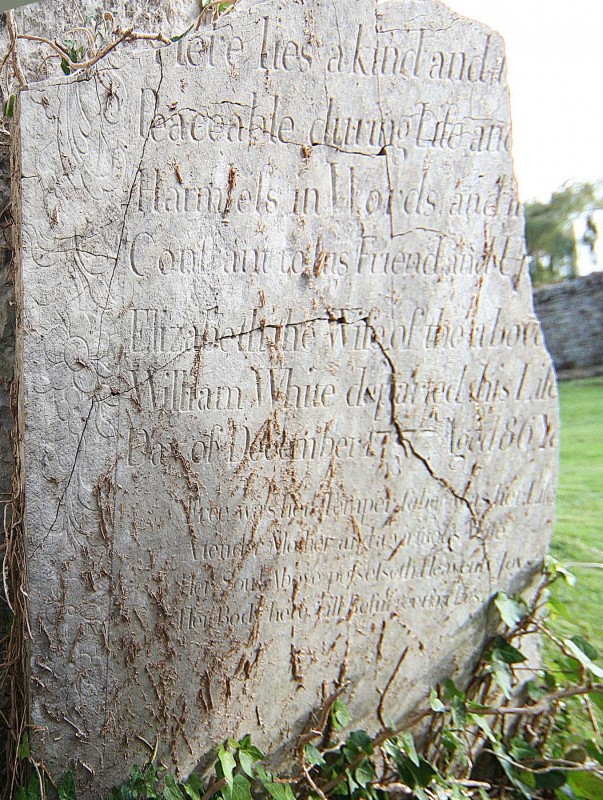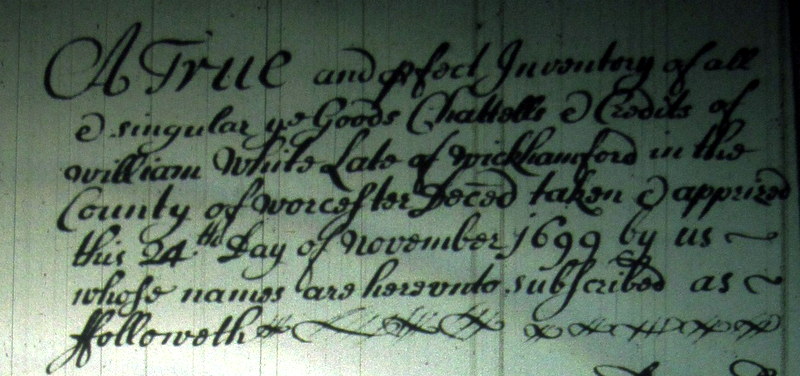Amongst the details of the Wills of residents of Wickhamford, the Will of William White is of particular interest given its detail. The inventory showed that the value of his estate was worth £603-16s-06p. A large sum of money compared to the value of the other inventories around that time and the equivalent of about £80,000 today in terms of purchasing power.
William had made his will on the 24th June 1697 and was buried in Wickhamford Churchyard on 20th November 1699. The appraisal of his goods, chattels and credits took place on the 24th November 1699 and the appraisers were Samuel Smith, John Aldington and Edward Smith. William White had come to Wickhamford around 1650 and The Manorial Court record for 30th April 1650 states :-
‘The surrender is presented of Francis Knight and his wife and son of their whole estate to Richard White and son William for the sum of £300. The parties are in court and the Lord grants the estate to Richard and William White who are admitted..’
There is a record at The Hive in Worcester (ref 705:962/8965/7/1V), dated 1650, that states that :–
‘Demise from Richard White of Wickhamford and William White his son to Thomas Chaucer of Childswickham of lands in Broadway and common pasture for 60 sheep in Broadway’.
So it appears Richard and his son were giving up land in Broadway at the time they were taking over the land at Wickhamford. No evidence has been found, to date, of where William was born but the Broadway parish records show the baptism of several children between 1629 to 1640 whose father was Richard White.
‘Yeates’ and ‘Julians’ – pastures in Wickhamford and their associated messuage
From the Court Rolls the Manorial Court for 23rd October 1632 it is recorded that the Stewards granted to John Acton and Francis Ffollyot a messuage (house) and one yard of land called ‘Yeates’ (approximately 20 acres). Also a messuage and one yard of land called ‘Julians’. These premises were formerly in the occupation of Margaret Spooner. (John Acton, described as a gentleman, did not always obey the Manorial Court rules. In 1635 he was indicted at the Worcestershire quarter sessions for not scouring his ditch. At the Court of 1638 he was presented for cutting four elms without licence. The Court of 10th April 1639 shows that he did not keep his outhouses in repair and tenantable and ordered to amend the outhouses before midsummer. The Court of 9th October 1646 showed that Acton had allowed three houses to decay and be out of repair.)
The Manorial Court for 7th January 1647/8 showed that John Acton and Francis Ffollyot surrendered ‘Yeates’ and ‘Julians’. The next occupants of ‘Yeates’ and ‘Julians’ were Francis Knight and his son Richard ‘now 14 years old’. For some reason the Knight family were only in occupation of the estate for the short period from 1647/8 to 1650 and they then passed to the White family.
The White family in Wickhamford
From the inscription on William White’s tombstone that stands in Wickhamford churchyard he was 62 when he died so would have been only 13 years of age when he took over the estate with his father Richard. (There is no mention of Richard in the parish records for Wickhamford, so he was buried elsewhere).
William White’s wife was Elizabeth and although there is no record of the marriage taking place in Wickhamford presumably it took place around the early 1660’s as their first child was baptised in 1664.
The parish records for Wickhamford show :-
| Mary | baptised 6th October 1664; married 12th October 1690 to John Baylis. |
| Margaret | baptised 20th March 1665; married 8th July 1686 to Edward Smyth. |
| Anne | baptised 29th march 1669; married 22nd April 1697 Thomas Marshall of Abbots Salford. |
| Elizabeth | baptised 19th March 1673. |
| Alice | baptised 15th November 1677. |
| William | baptised 7th April 1681. |
William and his wife must have delighted when a son and heir was born after five daughters !
William’s wife, Elizabeth, pre-deceased him, dying in 1692 and was buried in the Churchyard on 7th October, but there is no mention of her on her husband’s headstone.
The Will of William White
In his Will, William White made the following bequests:-
| Elizabeth (daughter) | £150 ‘plus a share of the household goods’ |
| Alice (daughter) | £150 ‘plus a share of the household goods’ |
| Margaret Smyth (daughter) | £30 ‘as an addition to her portion by me already paid’ |
| Elizabeth Smyth (granddaughter) | £5 |
| Mary Smyth (granddaughter) | £5 |
| William White (son) | The balance of the estate plus a share of the household goods plus the goods in the ‘Spall’, one ‘ffurmo’, a Maultmill and a Sidermill |
A ‘ffurmo’ is possibly a long bench or form; ‘Maultmill’ is a malt mill and ‘Sidermill’ a cider mill. The meaning of the ‘Spall’ is not known.
His son William and his three sons-in-law were appointed as executors. The sons-in-law were bequeathed 20 shillings each. There is no mention in the will of his other daughters, Mary and Ann, so perhaps they had already received a sum of money from their father in his lifetime.
The poor of the parish of Wickhamford received 20 shillings.

Will,m WHITE, who departed
this life November th19.1699.
Aged 62 years.
To leave this painful life I did desire,
That I to heavenly mansions, might aspire
Wherefore I laboured with all my might,
To gain acceptance in my Saviours light,
knowing that you & I must once appear
Before ye Judgement seat of God to hear
Our final doom and if ye good account
(Exceed ye bad) then to Heaven
Shall mount.
Kind reader therefore seek his love to gain,
Who unto Bliss, or, who, can us ordain.
Headstone of William White (Senior), in Wickhamford Churchyard, and Inscription.
The Inventory attached to the Will gives some idea of the size of house where the family were living. There were 5 bedrooms described as chambers, a hall and kitchen. The bedrooms appear to be well furnished as is the hall and there is a good supply of equipment in the kitchen. There is also plenty of linen and blankets for the beds.
Inventory
| £ | s | d | |
| The wearing apparel & money in his purse | 40 | 00 | 00 |
|
The bed with the furniture thereunto belonging with one chest of drawers, hanging press, one side cupboard, one coffer, with other furniture in the loft Chamber |
13 | 00 | 00 |
| The Chamber over the Dayhouse, one bed with ye furniture thereunto belonging , one Chest, one cupboard, 3 chairs | 5 | 00 | 00 |
| The Chamber over the Hall, one feather bed, one flock bed, with ye furniture belonging to them, one coffer with other furniture | 6 | 00 | 00 |
| The Chamber over the kitching one flock bed with ye furniture thereunto belonging with one coffer one screen with other furniture | 3 | 10 | 00 |
| In ye Chamber over ye Entry two flock beds with ye furniture thereunto belonging and other furniture | 2 | 10 | 00 |
| The furniture in the Hall three tables six chairs one fforme two stooles one cupboard with wainfooting | 5 | 00 | 00 |
| In the Kitching one table one furnice one dresserbord with other Furniture | 3 | 00 | 00 |
| Two Great kettles two little Kettles two bell mettle potts two brass pans two skillets one brass Ladle one skimmer | 5 | 00 | 00 |
| The Pewter Ten Great Dishes six plates two Porringer Dishes one pewter Tankard three pewter Candlesticks | 2 | 04 | 00 |
| Two spits one jack one paire of handirons two paire of toung two fire Shovels one Grate one iron Dripping panne | 1 | 15 | 00 |
| Eleven Barrells six Cowles four pailes one mault mill a sider mill | 5 | 14 | 06 |
| Thirteen pairs of sheets besides the seven pairs belonging to the seven beds one Doz & half of napkins six table clothes six pillow cases four pairs of blankets besides those that belonging to the beds which are seven pairs | 6 | 15 | 00 |
| In the house one pigge of bacon about three hundred of Cheese | 6 | 00 | 00 |
| Bookes and other tempory things in ye house | 2 | 10 | 00 |
| His Leasehold Estate | 200 | 00 | 00 |
| The wheat which is growing with that which is in the house & barne with a Rick without in the Rickyard | 80 | 00 | 00 |
| The barley & the other grains | 50 | 00 | 00 |
| Six Drawing horses & two Colts | 50 | 00 | 00 |
| Seven Cows & four heifers | 50 | 00 | 00 |
| The flock of sheep are 96 | 40 | 00 | 00 |
| Two fatting piggs with 3 store pigs | 6 | 00 | 00 |
| Plowes Carts Geeres & other Implem’ts of husbandry | 20 | 00 | 00 |
| One hayrick with other fodder | 20 | 00 | 00 |
| 603 | 16 | 06 |
The latter part of the Inventory gives some idea of his farming activities and he appeared to be a farmer of some substance. Some £236 of the total value of the inventory related to his farming business, a considerable sum for 1699.
William and his father, Richard White, had paid £300 when taking over the lease of the land at Wickhamford but in the inventory his leasehold land was only worth £200.
In his Will, William’s freehold land named ‘Horse Croft’ situated in Mickleton, Glos is referred to but there is no mention of its value in the inventory. This was probably not part of the appraisers brief. The freehold land in Mickleton passed to his son William (b. 1681) and is referred to in his will dated 5th December 1767.
The value of the Inventory based on the current Retail Price Index shows that it had a purchasing power of £80,000, but similar calculations based on earnings would value the Inventory at about £1,300,000.
(A picture of the introduction to the Inventory is in the Appendix).
William White’s House
In September 1972 the Revd Peter Braby wrote an article about the Inventory of another yeoman farmer William Spooner who had died around one hundred years before William White. The Inventory, dated 1601, shows a value of £84 5s 10p but added that there were debts of £35. The Revd Braby was sure that Spooner was living at Wickhamford Manor. As Richard and William White had taken over ‘Yeates’ and ‘Julians’, that had been occupied by Margaret, the widow of William Spooner, it might be imagined that was where William White was living too. However, this was not feasible as at certain times between 1650 and 1699 members of the Sandys family were in residence at the Manor. Samuel Sandys [1615-1685], Govenor of Evesham during the Civil War, had moved back to the family seat at Ombersley Court, where he is buried. However, his second wife, and widow, Elizabeth nee Packingham and one time wife of Col Henry Washington, lived at Wickhamford Manor until her death in 1698. Her daughter by her first marriage, Penelope Washington, also lived at the Manor was buried in the Chancel of the Church in 1697.
William White was certainly living in a sizeable property in view of the fact that it had five bedrooms. It is not known where the messuage and one yard lands of ‘Yeates’ and ‘Julians’ were situated in the village. There is perhaps, one property that survives that may be a contender for the White family home and it is Elm Farm, built ca 1560. There were two fields of about 20 acres behind and to the South of the house.

William White junior
William White’s son, also William, remained in the village and the baptism of his children are noted in the church records together with some of their marriages.
There is no mention in the Manorial Court records that William White junior took over his father’s leasehold land and property in Wickhamford. He may have done so, but his name does not appear as a tenant in any of the remaining Manorial Court records, from 1700-1716.
Although William White junior made a Will there is no inventory attached or value of his estate to compare with the value of his father’s estate. He lived to a great age dying at the age of 86 and there is a headstone in the Churchyard for him and his wife Elizabeth.

Here lies a kind and a..........
Peaceable during life and ....
Harmless in Words and ....
Contraint to his Friend and ...
Elizabeth the Wife of the above
William White departed this Life ........
Day of December 1777 aged 86 Ye[ars]
Free was her Temper to be was her Life
A tender Mother and a virtuous Wife
Her Soul Above posseseth heavenly Joy
Her Body here till resurection lies.
Headstone of William White (junior) and his wife, Elizabeth, in Wickhamford Churchyard, and Inscription.
Acknowledgement – We are grateful to Peter Stewart for supplying the photographs of the White family headstones and for transcribing the inscriptions.
Appendix

Val Harman & Tom Locke - March 2015
